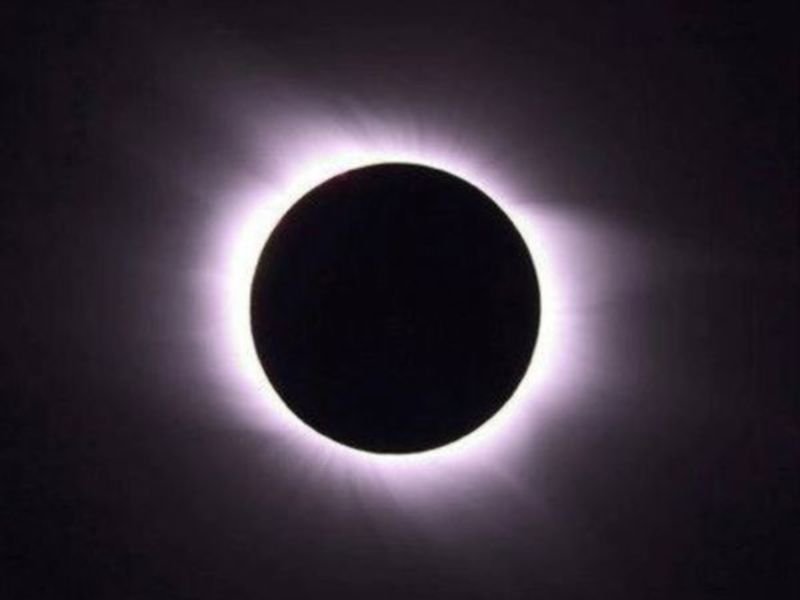A total solar eclipse provides an ideal opportunity to observe the corona because the sun itself is entirely obscured by the moon. The inner layer of the chromosphere also appears for a brief time during the eclipse as a shimmering pink-white ring.
NASA will measure changes in the corona's magnetic field and temperature from a variety of locations in both space and on Earth. Researchers are hoping to gain new insight on the massive gas eruptions taking place on the sun. They will also seek to better understand why the temperature of the sun's atmosphere, which can reach 3 million degrees, is so much hotter than the sun's surface below.
- MOON: During the eclipse NASA's Lunar Reconnaissance Orbiter probe (LRO) will observe the moon's shadow, which will move across the US from west to east.
The moon is not perfectly round but rather has the shape of an irregular polygon. The core shadow's changing shape is a result of solar rays providing a sharp outline of the moon's uneven surface as well as its mountains and valleys.
- EARTH: When the moon obscures the sun, it will mimic nightfall on Earth where its shadow falls. Not only will the light vanish, but the temperature will also drop. Plants and animals will revert to nocturnal modes.
In a concerted action on Monday, researchers will gather information about Earth's radiation budget via numerous measurements from Earth and space. Among the questions researchers have posed: How much sun energy is absorbed by the Earth's atmosphere? How much is reflected back into space? The data will also assist in determining the effects of cloud cover.
- BALLOON PROJECT: A high-altitude balloon project will shadow the solar eclipse.
Fifty teams, including universities and high schools along and outside of the core shadow zone - the so-called "zone of totality" - have spent months preparing high-altitude helium balloons equipped with cameras. The cameras will photograph and film the eclipse from the edge of the atmosphere at an altitude of 30 kilometres, from which they will be able to capture the full wavelength spectrum and send live images back to Earth.
- CITIZEN SCIENTISTS: Many non-scientists are expected to pitch in on data collection during the eclipse.
They can, among other things, use special apps to record temperature and atmospheric changes or any unusual animal behaviour. Others have formed a network of 68 telescopes to record the eclipse and create a high-resolution film of the event.
-------------------------------------------------------------------------------------------------------------------------------
NASA will measure changes in the corona's magnetic field and temperature from a variety of locations in both space and on Earth. Researchers are hoping to gain new insight on the massive gas eruptions taking place on the sun. They will also seek to better understand why the temperature of the sun's atmosphere, which can reach 3 million degrees, is so much hotter than the sun's surface below.
- MOON: During the eclipse NASA's Lunar Reconnaissance Orbiter probe (LRO) will observe the moon's shadow, which will move across the US from west to east.
The moon is not perfectly round but rather has the shape of an irregular polygon. The core shadow's changing shape is a result of solar rays providing a sharp outline of the moon's uneven surface as well as its mountains and valleys.
- EARTH: When the moon obscures the sun, it will mimic nightfall on Earth where its shadow falls. Not only will the light vanish, but the temperature will also drop. Plants and animals will revert to nocturnal modes.
In a concerted action on Monday, researchers will gather information about Earth's radiation budget via numerous measurements from Earth and space. Among the questions researchers have posed: How much sun energy is absorbed by the Earth's atmosphere? How much is reflected back into space? The data will also assist in determining the effects of cloud cover.
- BALLOON PROJECT: A high-altitude balloon project will shadow the solar eclipse.
Fifty teams, including universities and high schools along and outside of the core shadow zone - the so-called "zone of totality" - have spent months preparing high-altitude helium balloons equipped with cameras. The cameras will photograph and film the eclipse from the edge of the atmosphere at an altitude of 30 kilometres, from which they will be able to capture the full wavelength spectrum and send live images back to Earth.
- CITIZEN SCIENTISTS: Many non-scientists are expected to pitch in on data collection during the eclipse.
They can, among other things, use special apps to record temperature and atmospheric changes or any unusual animal behaviour. Others have formed a network of 68 telescopes to record the eclipse and create a high-resolution film of the event.
-------------------------------------------------------------------------------------------------------------------------------









 Home
Home Politics
Politics











